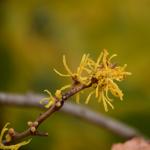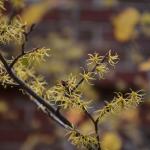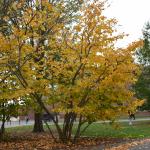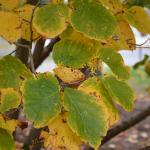A monthly e-newsletter from UMass Extension for landscapers, arborists, and other Green Industry professionals, including monthly tips for home gardeners.
To read individual sections of the message, click on the section headings below to expand the content.
To print this issue, either press CTRL/CMD + P or right click on the page and choose Print from the pop-up menu.
2024 UMass Garden Calendar
Purchasing plants for the landscape can be a considerable investment of both time and money. Selecting the right plant for the right place is the first step in making the most of this investment. This means selecting the best-suited plant material for your location according to light exposure, water availability, hardiness zone, soil conditions, and environmental exposure. The next step, and just as important to success, is following proper planting procedure.
Our 2024 calendar includes guidelines for preparing the planting hole, avoiding problems with circling roots, amending the soil before planting, and shares the results of a two-year UMass study looking at plant establishment success using different root preparation methods at planting.
UMass Extension works with the citizens of Massachusetts to help them make sound choices about growing, planting, and maintaining plants in our landscapes, including vegetables, backyard fruits, and ornamental plants. Our 2024 calendar continues UMass Extension’s tradition of providing gardeners with useful and practical information. Many people also love the daily tips and find the daily sunrise/sunset times highly useful!
Show your clients that you appreciate their business this year! Special pricing is available on orders of 10 copies or more.
COST: $14.50; shipping is FREE on orders of 9 or fewer calendars - FREE SHIPPING ENDS NOV 1! (Note: There is no free shipping on bulk orders of 10 or more.)
FOR IMAGES IN THE CALENDAR, details, and ordering info, go to http://ag.umass.edu/gardencalendar
As always, each month features:
- An inspiring garden image.
- Daily gardening tips for Northeast growing conditions.
- Daily sunrise and sunset times.
- Phases of the moon.
- Plenty of room for notes.
- Low gloss paper for easy writing.
Featured Plant
Hamamelis virginiana - Common witchhazel
 The party starter or the last to arrive? I tend to like to think of Hamamelis virginiana as the witchhazel party starter, beginning to bloom in October and lasting into December in some parts of the state. Common witchhazel ushers in a progression of other Hamamelis species and hybrids that bloom from January to March. Our only New England native Hamamelis species, common witchhazel often doesn’t get the attention of the Hamamelis x intermedia hybrids. This in part has to do with the unique blooming time of the species. The bright yellow, fragrant flowers form along the branches when the plant's yellow fall foliage is still present, somewhat obstructing the view of the show. Flowers fortunately can persist until after leaf drop, providing a late season floral display.
The party starter or the last to arrive? I tend to like to think of Hamamelis virginiana as the witchhazel party starter, beginning to bloom in October and lasting into December in some parts of the state. Common witchhazel ushers in a progression of other Hamamelis species and hybrids that bloom from January to March. Our only New England native Hamamelis species, common witchhazel often doesn’t get the attention of the Hamamelis x intermedia hybrids. This in part has to do with the unique blooming time of the species. The bright yellow, fragrant flowers form along the branches when the plant's yellow fall foliage is still present, somewhat obstructing the view of the show. Flowers fortunately can persist until after leaf drop, providing a late season floral display.
Flowers have four crinkly, strap-like petals that are extended in warmer weather and curl up when temperatures drop near freezing. Fruits are green seed capsules that become woody with age and can persist on the plant from winter through the following growing season. Seeds capsules split open in the fall of the following year and “explode”, sending seeds up to 30 feet away. Hamamelis virginiana is an important pollinator species, serving as one of the last native flowering plants and food sources for pollinators.
The native range is Nova Scotia to Florida west to Minnesota and Texas. Both in its native habitat as well as when used in the landscape, common witchhazel is a large multi-stemmed shrub. It can also be trained to have more of a small tree form in the landscape. Native Americans used Hamamelis virginiana for its healing properties as did European settlers later.
Common witchhazel has no serious insect or disease issues. Plants grow well in full sun to part shade, with best flowering in full sun. A moist, acidic, organically rich well-drained soil is preferred; however, plants can tolerate even heavy clay soil. Suckers should be removed to prevent spreading. Hamamelis virginiana is well suited for woodland gardens and shrub borders. In cultivation, plants grow 15-20’ tall and wide, making them a suitable choice for a small landscape tree, screen, or tall hedge.
Looking for a late season pollinator plant or a unique fall blooming shrub? Look no further than our native Hamamelis virginiana.
Mandy Bayer, PhD, Horticulturist and Landscape Plant Specialist
Trouble Maker of the Month
Pest Alert: Spotted Lanternfly Detected in Three New Massachusetts Communities
 The invasive spotted lanternfly (SLF) has recently been confirmed in both Hampden and Worcester Counties in the towns of Holyoke, Agawam, and Southborough, MA. These represent three new established populations of this insect in addition to those known previously in Fitchburg, Shrewsbury, Worcester, and Springfield, MA. Click here for an updated map of these locations from the MA Department of Agricultural Resources (MDAR).
The invasive spotted lanternfly (SLF) has recently been confirmed in both Hampden and Worcester Counties in the towns of Holyoke, Agawam, and Southborough, MA. These represent three new established populations of this insect in addition to those known previously in Fitchburg, Shrewsbury, Worcester, and Springfield, MA. Click here for an updated map of these locations from the MA Department of Agricultural Resources (MDAR).
Spotted lanternflies feed on many plant species, including grapes and tree-of-heaven. Both the adult and immature life stages of the spotted lanternfly use piercing-sucking mouthparts to feed on their host plants. They remove massive quantities of host plant fluid and excrete it as a liquid excrement known as honeydew. Spotted lanternfly is considered to be a plant stressor which, when combined with other biotic or abiotic plant stresses, may contribute to significant damage to their host plants. However, some hosts (grapes, tree-of-heaven, maple, black walnut) may be at more risk than others. Feeding damage can also result in yield loss or quality reduction of agricultural crops.
It remains important to report spotted lanternfly if you see it in Massachusetts to the MA Department of Agricultural Resources at https://massnrc.org/pests/slfreport.aspx.
Click here for more information about spotted lanternfly management for professionals from UMass Extension. More information for homeowners is also available from MDAR at: https://massnrc.org/pests/linkeddocuments/SLFHomeownerMgmtGuide.pdf.
Tawny Simisky, UMass Extension Entomologist
Q&A
A tick bite can occur at any time; risk is never zero. However, the chance that a person will encounter a tick ebbs and flows over the course of a year. This depends a great deal on the weather patterns we have, but it also depends greatly on which life stage is active. Here are some of the most frequently asked questions regarding deer tick (Ixodes scapularis) activity.
How come I haven’t been seeing ticks lately?
It might seem this way, but trust me, ticks are coming back this fall. My advice is to re-treat your clothing with permethrin and get back into the habit of daily tick checks. During the hot summer months, the larval stage is what is mainly active. This is the youngest stage and they rarely bite humans. Instead, they prefer to bite small birds and rodents.
Other factors include hot, dry weather. Deer ticks desiccate rapidly and will seek harbor in moist microclimates. The degree of rainfall can influence host-seeking behavior both positively and negatively.
Larvae pose the lowest risk to humans. They never carry the pathogens that cause Lyme disease, Anaplasmosis, and Babesiosis. They must first feed on an animal carrying that particular disease. We will get into more of this later.
When is tick “season?”
 Though a tick bite can occur any time of year, April - June is generally thought of as “tick season.” During this time, deer tick nymphs, American dog ticks, and lone star ticks can all be found. While the deer tick nymphs become scarce after June, American dog ticks and lone star ticks will remain.
Though a tick bite can occur any time of year, April - June is generally thought of as “tick season.” During this time, deer tick nymphs, American dog ticks, and lone star ticks can all be found. While the deer tick nymphs become scarce after June, American dog ticks and lone star ticks will remain.
In stark contrast to larvae, nymphs pose the greatest risk to humans. Nymphs are the first life stage to carry the full suite of disease-causing pathogens and will readily bite humans. Being so small, nymphs are more likely to go unnoticed and feed for extended durations.
The timing of nymphal activity is also critical to the cycle of pathogens. Nymphs feed shortly before the larvae of the next generation do. Any infected nymphs can pass their germs on to uninfected animals in the environment. Those newly infected animals serve as reservoirs that the newly hatched (and pathogen-free) larvae feed on during the summer months.
Do deer ticks hibernate?
While not hibernation per se, deer ticks will go into diapause. Depending on the life stage and circumstances when cold weather arrives, this can be either a break in activity or in development.
Example 1: A larval tick that has fed may delay molting until the next year.
Example 2: An adult deer tick may delay egg laying for several months.
Do deer ticks die off in the winter?
Short answer: No. Deer ticks are well adapted to surviving cold temperatures. Ticks synthesize glycerol (an antifreeze compound) and will use leaves and snow as insulation. You can encounter an adult deer tick any time temperatures are above freezing. However, they tend to be much more active above 40°F. Remember that adults also pose a high risk to humans. They will readily bite humans, and while easier to spot, they tend to harbor a higher rate of infection, having fed twice before.
Blake Dinius, Plymouth County (MA) Entomologist
Garden Clippings Tips of the Month
October is the month to . . . .
In the Vegetable Garden
- Clean up vegetable crop debris like tomato and squash plants to reduce harboring important disease and insect pests. Remove crop debris and compost or till promptly into the soil for quick breakdown.
- Do a soil test. Now is a great time to do a soil test. Soil testing can help identify problems and inform proper fertilizer use in the vegetable garden. For details, see the UMass Soil and Plant Nutrient Testing Laboratory web site.
- Plant a cover crop. Cover crops are fundamental components of organic gardening. For gardeners, terminating cover crops like winter rye has traditionally been a difficult task. Recently farmers and gardeners have been exploring the use of tarps to terminate cover crops. For best results, establish a dense cover crop with high biomass. In spring, roll the cover crop with something heavy and cover with a black tarp. Remove tarps after 3-4 weeks and plant transplants through the mulch-like cover crop residue.
- Don’t forget the garlic. October to early November is an ideal time to plant garlic. Plant garlic roughly finger deep after first frost and mulch before consistent hard freezes.
In the Flower Garden
- Finish dividing and planting. Dividing and planting projects should be completed at least 6 weeks before soils freeze. In eastern Massachusetts, Indigenous Peoples' Day is a good target date. Mulch liberally to avoid heaving.
- Dig summer bulbs like cannas, dahlias, elephant ears, gladiolus, and tuberous begonias. Dig bulbs on a dry day, wipe or brush soil off; don’t wash. Place bulbs in wood shavings or peat moss and store in a cool dry place.
- Leave spent flowers and stems in the garden for winter interest and as a resource for wildlife. Purple coneflower and rudbeckia flowers attract goldfinches well into the fall and early winter; many beneficial insects overwinter in dead stems.
On the Lawn
- Fall represents one of the most important seasons for lawn growth. Cool conditions and ample soil moisture are ideal for growing roots and building reserves for the winter. Manage fallen leaves to allow sunlight to reach the grass. Leaves that are raked or blown can be repurposed in other areas of the property as mulch or as overwintering habitat for beneficial insects. Mulch-mown leaves can help contribute to soil organic matter.
- Avoid soil compaction. Fall conditions often include wet soils which are easily compacted by ordinary yard equipment. When projects include repeated travel of equipment like heavy wheelbarrows, use sheets of plywood to help distribute their weight and avoid soil compaction.
Trees & Shrubs
- With so much precipitation this growing season, some tree and shrub species have experienced a lot of fungal leaf spots and foliar diseases. Many foliar diseases survive over the winter on fallen leaves. Leaves from trees with a lot of foliar disease should be removed and/or composted to avoid contributing to disease recurrance next season.
- When foliar disease is not an issue, leaves can be a valuable resource. Leaves make good mulches, can help build soil organic matter, and provide habitat for many invertebrates. Leaves from walkways, driveways, patios and lawns can be collected and used as mulch in borders or natural areas.
Russell Norton, Horticulturist, Cape Cod Cooperative Extension
Is Fall for Planting?
Here in the Northeast, we’ve grown accustomed to the adage “Fall is for Planting.” After all, whether it’s a lone specimen tree for our yard, or performing a large community urban planting effort, we know that there are many factors that work together to make the onset of autumn a potentially more ideal time to establish the woody plants that we so desire.
Even the most humble agronomist will argue that it’s about the soil. And since research has historically told us that important factors like soil temperature, water and nitrogen availability can fluctuate and influence root respiration and growth, it is important to give careful consideration as to what is taking place “below ground” in the fall. While preferential conditions may vary, several weeks of 60-70° F at a 6-12” depth has been one of the standard ranges considered desirable for the root growth and development necessary for successful plant establishment. Additionally, increased soil moisture levels – often as a result of decreased daytime temperatures – aid in the increased mineralization of nitrogen, making the subsurface environment even more hospitable for woody plant roots.
In addition to soil-related factors, we know that many of the physiological changes that take place in a desirable woody ornamental near the end of the growing season make the plant itself more conducive to planting. By the end of summer, trees are generally producing little – if any – shoot growth and are well into the seasonal “hardening off” (forming lignified tissue, setting buds) phase. Since they typically require less water at this time of year, they are less prone to the stresses related to moisture levels and may not require any supplemental water to facilitate establishment, other than natural rainfall. They are also better able to delegate the resources they are still deriving from ongoing photosynthesis to root growth and development, which will continue as long as soil temperatures remain above 40-45° F. Selection of the planting site itself may be a simpler task leading up to fall planting, as the mounds of ice and snow have yet to accumulate and aspiring tree planters are better able to consider the “right place” component of the adage, “right tree, right place”.
By now one may ask, are there any drawbacks associated with planting in the fall? As with nearly all situations, there are almost always positive and negative factors worthy of consideration. By the time we reach the latter stages of the growing season, plant availability in the nursery or garden center may be limited, begging certain questions about the specimens that remain: When exactly was this tree dug?? What sort of shape is this plant in?? If this shrub was awaiting being planted, where was it being held and what sort of attention did it receive throughout those hot summer months?? The list goes on.
And what of those “fall rains” that everyone speaks of? Do the data really show that we experience an increase in precipitation after the hot, hazy, humid days of July and August? When we look at the most recent 30-year average of weather data throughout the Northeast, we see that in most years the summer months (June-August) were in fact wetter than the fall months (September – November) and offered on average 9.2% more rainfall! This may be especially troublesome in a growing season where parts of the Northeast have well below normal summer rainfall levels. In addition to less rain in the fall months, evapotranspiration rates (the rate at which plants “lose” water) can be surprisingly significant in the fall as humidity levels drop, resulting in plant water loss.
In addition to seasonal moisture levels, it has also been documented that difficult-to-transplant trees like some of the oaks (Quercus spp.), black-gum (Nyssa sylvatica), and hop-hornbeam (Ostrya virginiana) may not establish well following a fall planting. Other common urban trees that may receive a cautionary warning about being planted in the fall include some of the maples (Acer rubrum), birches (Betula spp.), dogwoods (Family: Cornaceae), bald-cypress (Taxodium distichum), lindens (Tilia tomentosa), golden rain-tree (Koelreuteria paniculata), Zelkova (Zelkova serrata), pear (Pyrus spp.) and blue-beech/hornbeam (Carpinus caroliniana).
Of course, one of the primary concerns associated with fall planting relates to the relationship between the sudden onset of cold weather and the time of installation. Though our warming climate has been extending the planting window with first freeze dates routinely occurring increasingly later, a rule of thumb includes the installation of deciduous plants from late August through early October in most parts of Massachusetts (Zones 4-6). A plant that hasn’t yet successfully become established, however, may be especially prone to injury from an early freeze or from pending freeze-thaw cycles, which have been a regular occurrence in recent years. The coup de grâce may be the prolonged, harsh conditions associated with a New England winter that may bring a poorly established tree to its demise. Ultimately, good planning related to species selection and the application of best practices may dictate the success of a fall tree planting. Follow-up stewardship efforts like regular watering, mulching, and weeding can help to mitigate against unforeseen factors. So perhaps we might tweak the adage “Fall is for Planting” to “Fall is Often for Planting”.
For more information, the classic Cornell Guide for Planting and Maintaining Trees & Shrubs by Professors George Good & Richard Weir III, Cornell University, may be downloaded for free at: www.tinyurl.com/goodweir. The authors gratefully acknowledge the input of Jessica Spaccio and the staff of the Northeast Regional Climate Center.
Candace Powning and Prof. Rick Harper, Department of Environmental Conservation, University of Massachusetts Amherst
Upcoming Events
For details and registration options for these upcoming events, go to the UMass Extension Landscape, Nursery, and Urban Forestry Program Upcoming Events Page.
- SAVE THE DATE! In-person Fall Wrap-Up for Landscape and Lawn Care, Nov. 29, Milford MA. Details coming soon.
- Invasive Insect Certification Program, Oct. 10, 11, 25, 26, live via GoToWebinar, 9:30 - 12:30 pm. The remaining webinars in this series look at the characteristics of invasive insects, the impacts and costs they have regionally and nationwide, and highlights the biology, ecology, and identification of some of the most destructive insects. Pre-registration required. 2 pesticide contact hours for categories 29, 35, 36, 48, and Applicator's (Core) License for each webinar; 1 MCLP, 1 MCA, 1 MCH, 2 (cat 1) CFE credits available; ISA and SAF credits requested.
Pesticide Exam Preparation and Recertification Courses
These workshops are held virtually. Contact Natalia Clifton at nclifton@umass.edu or go to https://www.umass.edu/pested for more info.
Additional Resources
For detailed reports on growing conditions and pest activity – Check out the Landscape Message
For professional turf managers - Check out our Turf Management Updates
For commercial growers of greenhouse crops and flowers - Check out the New England Greenhouse Update website
For home gardeners and garden retailers - Check out our home lawn and garden resources
TickTalk webinars - To view recordings of past webinars in this series, go to: https://ag.umass.edu/landscape/education-events/ticktalk-with-tickreport-webinars
Diagnostic Services
Landscape and Turf Problem Diagnostics - The UMass Plant Diagnostic Lab is accepting plant disease, insect pest and invasive plant/weed samples. By mail is preferred, but clients who would like to hand-deliver samples may do so by leaving them in the bin marked "Diagnostic Lab Samples" near the back door of French Hall. The lab serves commercial landscape contractors, turf managers, arborists, nurseries and other green industry professionals. It provides woody plant and turf disease analysis, woody plant and turf insect identification, turfgrass identification, weed identification, and offers a report of pest management strategies that are research based, economically sound and environmentally appropriate for the situation. Accurate diagnosis for a turf or landscape problem can often eliminate or reduce the need for pesticide use. See our website for instructions on sample submission and for a sample submission form at http://ag.umass.edu/diagnostics.
Soil and Plant Nutrient Testing - The lab is accepting orders for Routine Soil Analysis (including optional Organic Matter, Soluble Salts, and Nitrate testing), Particle Size Analysis, Pre-Sidedress Nitrate (PSNT), Total Sorbed Metals, and Soilless Media (no other types of soil analyses available at this time). Testing services are available to all. The lab provides test results and recommendations that lead to the wise and economical use of soils and soil amendments. For updates and order forms, visit the UMass Soil and Plant Nutrient Testing Laboratory web site.
Tick Testing - The UMass Center for Agriculture, Food, and the Environment provides a list of potential tick identification and testing options at: https://ag.umass.edu/resources/tick-testing-resources.



